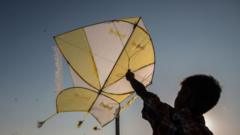In the sprawling paddy fields just two kilometers from Jakarta's bustling Soekarno-Hatta International Airport, a unique battle is taking shape. Here, children's laughter and the fluttering of kites clash with the roar of airplane engines cutting through the air. This space has become a battleground between two cherished aspects of Indonesian culture and modern safety regulations—kite-flying, a beloved pastime, and the rising concerns of airport authorities regarding aircraft safety.
As children tug at their colorful kite strings, their eyes remain alert for airport officials on patrol, ready to seize any kite that flies too high. Seven-year-old Atif candidly shares his experiences and how he has learned to face officers rather than flee. "If my kite is taken, it's sad, but I can always make another one," he reflects, showcasing the resilience and determination of youth.
Despite the joys of kite-flying, authorities have issued stern warnings regarding the potential hazards posed by these airborne objects. In early July, kites disrupted 21 flights at the airport, forcing some to divert to alternate locations and others to abort landing, illustrating the very real dangers that come with these colorful creations. "Kites are moving obstacles for planes and a serious risk to flight safety," asserts Putu Eka Cahyadi, head of the airport authority, echoing sentiments of precaution.
Past incidents loom large, with a helicopter crash in Bali related to entangled kite strings reminding the public of the potential consequences. As safety fears escalate, local and transportation officials have called for educational efforts to inform children about the risks while attempting to channel their passions into safer sports, like football and badminton.
However, kite-flying remains deeply ingrained in Indonesian culture, associated with traditions ranging from rice harvest ceremonies to spiritual offerings. Experts assert that while it's vital to address safety concerns, the cultural significance of this activity cannot be overlooked. "Kite flying has been passed down through generations from our ancestors," emphasizes Asep Irawan of the Indonesia Kite Museum.
With urban development encroaching on green spaces in Jakarta—31% lost between 2000 and 2020—opportunities for children to practice their beloved hobby have diminished. Rasha, a 17-year-old kite-maker, explains the dire lack of alternatives. "There's nowhere else around here," she laments, reflecting the community's struggle for recreational space amidst the grip of urbanization.
Despite the looming risks, the allure of flight continues to draw children to the paddy field, where enthusiasm outweighs fear. Memories of confiscated kites and official scoldings do little to deter their spirits; instead, the community finds strength and camaraderie amid the ongoing kite-flying competitions that have emerged in this space.
As efforts intensify to balance cultural practices and safety regulations, the future of kite-flying in Indonesia hangs in delicate equilibrium—where the skies remain a beautiful yet contested space.
As children tug at their colorful kite strings, their eyes remain alert for airport officials on patrol, ready to seize any kite that flies too high. Seven-year-old Atif candidly shares his experiences and how he has learned to face officers rather than flee. "If my kite is taken, it's sad, but I can always make another one," he reflects, showcasing the resilience and determination of youth.
Despite the joys of kite-flying, authorities have issued stern warnings regarding the potential hazards posed by these airborne objects. In early July, kites disrupted 21 flights at the airport, forcing some to divert to alternate locations and others to abort landing, illustrating the very real dangers that come with these colorful creations. "Kites are moving obstacles for planes and a serious risk to flight safety," asserts Putu Eka Cahyadi, head of the airport authority, echoing sentiments of precaution.
Past incidents loom large, with a helicopter crash in Bali related to entangled kite strings reminding the public of the potential consequences. As safety fears escalate, local and transportation officials have called for educational efforts to inform children about the risks while attempting to channel their passions into safer sports, like football and badminton.
However, kite-flying remains deeply ingrained in Indonesian culture, associated with traditions ranging from rice harvest ceremonies to spiritual offerings. Experts assert that while it's vital to address safety concerns, the cultural significance of this activity cannot be overlooked. "Kite flying has been passed down through generations from our ancestors," emphasizes Asep Irawan of the Indonesia Kite Museum.
With urban development encroaching on green spaces in Jakarta—31% lost between 2000 and 2020—opportunities for children to practice their beloved hobby have diminished. Rasha, a 17-year-old kite-maker, explains the dire lack of alternatives. "There's nowhere else around here," she laments, reflecting the community's struggle for recreational space amidst the grip of urbanization.
Despite the looming risks, the allure of flight continues to draw children to the paddy field, where enthusiasm outweighs fear. Memories of confiscated kites and official scoldings do little to deter their spirits; instead, the community finds strength and camaraderie amid the ongoing kite-flying competitions that have emerged in this space.
As efforts intensify to balance cultural practices and safety regulations, the future of kite-flying in Indonesia hangs in delicate equilibrium—where the skies remain a beautiful yet contested space.


















